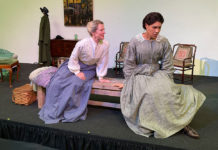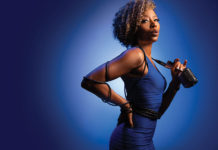Michelle is a writer of poetry and creative nonfiction, and her new monthly column “Off the Page” appears next week. She also has deep roots in community journalism, having most recently finished an 11-year stint with the “Calistoga Tribune.” She serves on the board of Redwood Writers and is a member of the Healdsburg Literary Guild. Michelle lives in Cloverdale with her wife and a menagerie. She is assisted in her creative endeavors by her service dog Ripley, never more than a few inches away.
Why do you write?
I write because my head is full. The words and images tumble around, pushing and shoving. Poems and essays create themselves whether I want them to or not. If I didn’t write, I would have to be committed to an asylum, permanently. That’s on a personal level. I also write because it’s my way to have an impact. I try to speak for those who may not be able to, for whatever reason – not by usurping their words, but by sharing my stories and vulnerabilities, hoping these resonate regarding issues of discrimination, social injustice, violence against women, etc.
What’s the best advice you were ever given about writing and how has that helped you?
Thea Sullivan, a writing teacher in San Francisco, told me to trust my own voice would emerge from my words. She guided me along the path of discovering voice, seeing certain vocabulary appear again and again in my early writing, serving as a hint of my personal insignia. Other writers could give inspiration, but my style would be exclusively mine; no one else would be able to create it. That’s a tool of expansiveness, generosity towards self. The other tool Thea gave was one of narrowing, equally necessary.
She taught how critical it is to cut down to the marrow of your poem, to whittle away all that does not serve to move the work forward. This lesson was harder. Once she read a 30-line poem I had written. She circled the last three lines, saying, “This is the poem. Start here.” I did not want to hear that. But she was right. And I ended up with a stronger piece.
What qualities do you possess that enable you to get lost in your creativity and when did you discover these?
I grew up in a house with six children, and my father, a CPA, worked at home. We all used to tease him, because he became such an expert at shutting out the noise. As kids, we knew if we wanted permission to do something, like ride our horses up the other side of the mountain, we should go ask Dad. He would absent-mindedly say yes, and have no recollection of it afterwards. But we would be able to honestly tell our mother we had received the parental OK.
I must have inherited this quality from him. I live in a house with my wife, four large dogs, and an embarrassing number of cats, all of whom seem to enjoy coming in and out of my writing studio when I am working. Yet I can completely tune all of it out and focus on the task at hand when I am in the zone. Just don’t put me in front of a television. I become a zombie head. That’s why we don’t ever turn it on.
What, if any, are your writing rituals?
I try to have writing habits, but I am abysmally poor at establishing them. Some writers do the “I write between 9 a.m. and noon every day” thing. I have attempted that, more than once, but fail. I am simply not a morning person. I do my best work at night, the later the better. And it is sporadic, unpredictable. What I do know is that deadlines help me. Perhaps it is the years as a journalist. But with a deadline, I can make things happen. So the more “get it to me by this date or else!” messages in my inbox, the better.
Please describe your desk and where you write.
My writing studio is like a cruise ship’s dessert table – something enticing everywhere you look. Although I am a Zen practitioner, this space is anything but Zen; it’s more a study in artistic indulgence. The walls are painted lime green and bright yellow. I have five bookcases, groaning under the weight of too many books. My “to be read” list is out of control. I believe I could lay a footpath made of books to the top of Mt. Kilimanjaro and still have a pile left over to stack on my nightstand. I am simply incorrigible. My thinking is, if it’s on my shelf, I’ll get to it eventually, right?
Artwork by friends or artists who have called out to me in some way covers all the remaining wall space. By the French door, which lets in a great deal of light, I have my altar, with its large Buddha statue, candles, incense bowl, and Japanese vases. I also have two art file cabinets containing the various things I use for non-writing creativity: assemblage projects, home-made greeting cards supplies, paints, colored pencils, Japanese papers, anything you could want.
My desk is in the middle of all this. I work primarily on my desktop computer, with a large monitor, but also have a laptop for mobile adventures. I sit in a simple straight-back chair, perched, eager – that’s control central.
If there were no limitations of any kind (meaning you could go back in history or forward in time), who would you most like to interview for your new column?
Because I lived in Japan for three years, and studied the culture and language of that country during graduate school
(I have an M.A. in Japanese Studies from the University of Washington), it would be fabulously fun for me to interview Sei Shonagon, a court attendant who lived during the Heian Period (794-1185). She’s most famous for penning “The Pillow Book,” which is a collection of essays, some serious, some wickedly funny. It contains “lists,” things she likes or dislikes, and penetrating insights into the court’s artistic culture. It would be a kick to get her take on the contemporary Sonoma Valley scene.
64
F
Healdsburg
April 12, 2025








